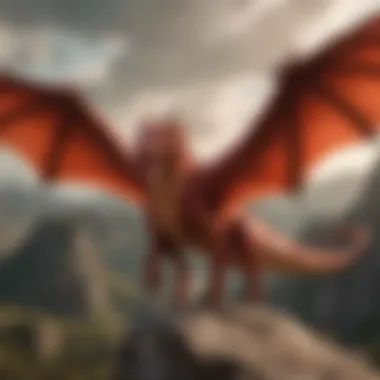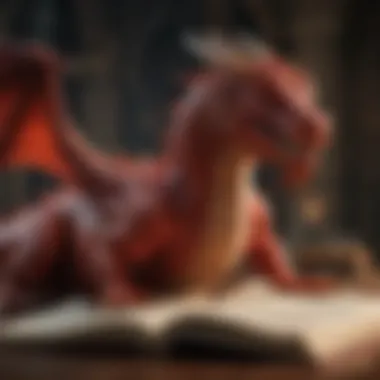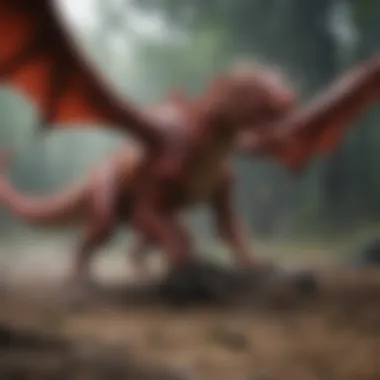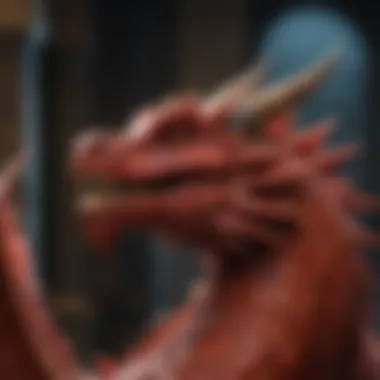Exploring the Red Dragon: Its Literary Significance


Intro
The red dragon is an enduring symbol in diverse literary works, particularly in the realm of fantasy. This creature exhilarates imagination and evokes power, danger, and mystery. Its significance lies not only in its visual representation but also in the layered meanings it carries. When one observes dragons across various cultures, variations emerge, yet the red dragon often seizes the spotlight, signifying strength, wrath, and sometimes, destruction.
An examination of the red dragon unveils its thematic weight in stories, especially through character portrayal and narrative dynamics. This article seeks to explore these intricacies, dissecting key literary texts that incorporate the red dragon and examining how this symbol has evolved within cultural narratives. By providing an in-depth analysis of its implications in storytelling, it hopes to offer a fresh perspective on the red dragon's contemporary relevance.
Character Dissections
Detailed Analysis of Key Characters
Delving into the narrative landscape, the red dragon resonates with numerous fictional figures, most notably Daenerys Targaryen from George R.R. Martin's epic series, A Song of Ice and Fire. Daenerys embodies complex traits of ambition, resilience, and vulnerability, intertwined with her dragons.
Her relationship with these creatures, particularly the red dragon, Viserion, illustrates a multifaceted connection that propels her character arc. As the series progresses, her initial sense of control over the dragons turns into a chaotic struggle for identity and power. This chaotic turn adds richness to her character and illustrates the turning point where ambition collides with unintended consequences.
Character Development Throughout the Series
Throughout the series, one can observe a significant evolution in Daenerys's character. She evolves from a timid girl marked by her brother's tyranny into a formidable ruler. The red dragon signifies her fiery spirit and her ambitions to reclaim the Iron Throne. However, her grasp on power is always shadowed by the potential for destruction — a direct reflection of the inherent nature of dragons.
The decisions she makes often echo the fierce temperament of her dragons. This connection emphasizes the duality of strength and chaos, making her journey compelling from a character-development standpoint.
Impact on the Overarching Storyline
Daenerys’s red dragon not only propels her narrative but also intersects with the larger themes of the series. The dragons serve as physical manifestations of her quest for power and the moral dilemmas she faces. The fire-breathing capabilities of dragons illustrate both literal and metaphorical destruction, highlighting the sometimes violent cost of ambition. Characters surrounding Daenerys react to the dragons with a mix of awe and fear, exemplifying how the red dragon becomes a focal point for tension and conflict within the storyline.
In essence, the significance of the red dragon cannot be understated in exploring character dynamics and their contribution to overall narratives. The representation of dragons in literature, particularly as tied to character development, reflects deep-seated themes in human behavior and societal structures.
Foreword to the Red Dragon
The concept of the red dragon carries significant weight in literary discussions. It is not just a creature; it symbolizes various themes and narratives that resonate throughout history. Understanding this topic is crucial for grasping its relevance in modern storytelling, especially within fantasy literature. The red dragon often embodies power, chaos, and transformation, acting as a crucial element in character and plot development. This introduction aims to set the stage for deeper exploration in subsequent sections. The readers will benefit from a comprehensive grasp of the red dragon's defining characteristics, cultural implications, and historical roots.
Defining the Red Dragon
The red dragon is characterized by its fierce appearance and formidable nature. In various texts, it typically symbolizes destructive forces or overwhelming power. As a literary device, it can represent inner struggles or external conflicts that characters face. This dual nature allows authors to weave rich narratives that explore themes of moral ambiguity and ethical dilemmas. The red dragon's vivid imagery evokes emotional responses, making it an effective tool for engaging readers. It creates a visceral connection between the audience and the text, enhancing the overall narrative experience.
Historical Origins and Mythology
Historically, the red dragon appears in numerous cultures and mythologies, serving as a powerful emblem with varied meanings. In Western traditions, dragons often signify chaos that heroes must confront and conquer. Conversely, in Eastern cultures, such as Chinese mythology, dragons can symbolize wisdom and benevolence. Understanding these origins is vital for comprehending how the red dragon has evolved in literature over time.
The red dragon's representation varies distinctly across cultures, reflecting societal values and beliefs rooted in the mythology of each region.
In Welsh mythology, for instance, the red dragon is associated with strength and sovereignty. This imagery helped shape the perception of dragons in later literary works, influencing how contemporary writers craft their narratives. By analyzing these historical aspects, readers gain insight into the dragon's flexibility as a symbol and its enduring relevance in storytelling.
Red Dragon in Fantasy Literature
The presence of the red dragon in fantasy literature serves as a pivotal element that influences narrative arcs, character development, and thematic depth. This creature often embodies various aspects such as power, greed, and chaos. Within the framework of storytelling, it evokes strong emotional responses from readers, thereby establishing a complex relationship with the text. The red dragon not only shapes the narratives but also enriches the world-building, creating a vivid backdrop for the protagonists' adventures.
Notable Representations in Texts


Throughout literature, the red dragon has manifested in distinct forms across multiple works. Notably, J.R.R. Tolkien's Smaug in "The Hobbit" captures this creature's essence as a guardian of immense treasure, emphasizing themes of greed and its consequences. Smaug’s cunning intelligence and ruthless nature illustrate how dragons can embody the darker traits of humanity itself.
In addition to Tolkien, George R.R. Martin's use of dragons in the "A Song of Ice and Fire" series provides another significant representation. Here, dragons act as powerful symbols of reclaiming lost power and identity, central to Daenerys Targaryen's character arc. This narrative showcases how the red dragon transcends mere beastly representation, acting instead as a metaphor for personal transformation aligned with legacy and history.
Other texts often include the red dragon as a creature of destruction, fear, and challenge for the hero. In these works, it may symbolize the ultimate test that the protagonist must face. Such representations reflect deep-rooted archetypes in mythology that resonate with the audience's collective memory.
Character Archetypes Associated with the Red Dragon
The red dragon often embodies various character archetypes in fantasy literature. Frequently, it represents the Antagonist, portraying a formidable obstacle for heroes. This antagonist is not limited to physical might, but often includes psychological manipulation, serving to heighten the stakes of the narrative.
Moreover, the Guardian archetype can be seen in representations of the red dragon when it protects something of great value, such as ancient knowledge or a treasure. This form often engages the protagonist in moral dilemmas, pushing them to confront their motivations and desires.
Finally, the Transformative Catalyst is another archetype the red dragon showcases. It is less about being evil and more about challenging the status quo. Encountering a red dragon can represent a turning point, forcing characters to undergo significant changes in mindset or purpose.
As these archetypes play out, they contribute to the overarching themes of conflict, growth, and transformation within the narratives.
"The red dragon is not simply a creature of myth but a reflection of the human condition, revealing our deepest fears and desires."
Overall, an understanding of the red dragon's role in fantasy literature lays a foundation for deeper engagement with the texts, allowing readers to appreciate the intricate interplay of themes, character development, and narrative structure.
Cultural Interpretations
Cultural interpretations of the red dragon provide significant insights into its multifaceted representation across different regions and traditions. This symbol transcends mere narrative function, connecting reader engagement with a deep-seated mythological and psychological framework. Understanding these cultural contexts allows readers to appreciate how the red dragon operates within distinct literary discourses, highlighting both universal themes and culturally specific nuances. This analysis will discuss the role of the red dragon in Asian mythology and Western symbolism, exploring its impact on audience perception and thematic depth.
The Red Dragon in Asian Lore
In Asian cultures, particularly in China, the red dragon holds an esteemed position as a symbol of power, strength, and good fortune. Unlike the antagonistic depictions prevalent in Western narratives, in Asia, dragons are often viewed as benevolent beings. They are associated with water, rain, and agriculture, playing a critical role in providing sustenance. The red dragon, or Zhong Long, is specifically revered for its fiery nature, representing vital energy and the heavens.
Cultural festivals, art, and folklore include celebrations of the red dragon, reinforcing its significance. Chinese New Year, for instance, features vibrant dragon dances symbolizing prosperity and protection. Folklore frequently portrays dragons as wise protectors who bestow blessings on those who show reverence. This positive depiction contrasts sharply with the ferocity traditionally associated with dragons in Western tales.
Moreover, the duality in the nature of the dragon highlights a broader thematic exploration in literature—how perception shapes narrative role. The red dragon serves as a metaphor for the complex interplay of good and evil, power and wisdom, thereby enriching narratives that incorporate it.
Western Symbolism and Theological References
In the Western literary canon, the red dragon often embodies chaos and destruction. It appears as a fearsome adversary, representing forces that threaten the moral order. This portrayal is notably seen in texts like The Bible, where the red dragon symbolizes Satan in the Book of Revelation. Such theological references ground the imagery of the red dragon in a Christian paradigm, linking it to sin and malevolence.
This negative symbolism has endurance across various forms of literature and media, including epic tales like Beowulf and modern fantasy series such as Game of Thrones. Here, the red dragon tends to symbolize power that corrupts and the inevitable tragedy of unchecked ambition. This makes the character dynamic richer and more layered, prompting readers to contemplate moral dilemmas embedded within the narrative.
"The red dragon serves not merely as a monster but as a vessel of thematic exploration, illustrating the balance of terror and allure in the pursuit of power."
These interpretations highlight the multifaceted nature of the red dragon, showcasing how cultural context significantly influences its representation. By contrasting the benevolent dragons of Asian heritage with the malevolent counterparts in Western lore, a broader understanding of the dragon's significance emerges, resonating with contemporary discussions on moral ambiguity in storytelling.
Thematic Analysis
The thematic analysis of the red dragon is crucial in understanding its multifaceted role within literature, especially in the realm of fantasy. Through this exploration, readers can uncover underlying meanings and cultural significance. The red dragon often embodies both tangible and intangible elements of narratives, such as conflict, ambition, and transformation. These themes resonate deeply with audiences, enriching their engagement with the text.
In literature, themes serve as the thread that ties narratives together. They guide the reader's emotional response and intellectual engagement. The red dragon’s presence often sparks discourse on moral complexities and human aspirations, making it a captivating symbol. Understanding these themes allows readers to appreciate the story's depth and the complexities of the characters involved.
Themes of Power and Destruction


The theme of power associated with the red dragon is particularly prominent. In many works, dragons symbolize raw power, commanding both fear and respect. Their physical might often reflects the characters' quests for dominance, whether in a political context or a personal journey. For example, in Game of Thrones, Daenerys Targaryen's dragons illustrate her growing power and the devastation that accompanies her ambition. The imagery of fire and destruction merges with the idea of uncontrollable power, highlighting the dangers of unchecked ambition.
This leads to another essential aspect: destruction. The red dragon often heralds chaos, representing the end of the old order. In various tales, its arrival signifies doom for kingdoms, as seen in John Milton's Paradise Lost where the dragon represents a malevolent force, commanding destruction. Here, destruction becomes a catalyst for change, often provoking the remaining characters to seek redemption or revenge.
Rebirth and Transformation Motifs
In contrast, the red dragon also symbolizes rebirth and transformation. This duality is evident in characters' journeys across narratives. Often, characters associated with red dragons undergo significant transformations, reflecting personal growth or moral questioning. For instance, in fantasy spheres, a hero rising from ashes often aligns with the red dragon motif, suggesting a profound change driven by prior destruction.
The themes of rebirth often interconnect with cycles in storytelling. The red dragon serves as a reminder that from destruction can come new beginnings. In many instances, characters may perceive the dragon as a challenge. Facing it could lead to personal evolution or societal change. This theme is prevalent in modern fantasy literature, encouraging readers to rethink how they view challenges and transformation within their lives.
"In many stories, dragons are not merely beasts to be slain but symbols of the struggles inherent in growth"
By analyzing these themes, readers gain deeper insight into the narrative structure and emotional stakes at play. The red dragon's role is not solely that of a fierce creature; it is entrenched in the human experience, mirroring our intrinsic struggles with power and the pursuit of identity through transformation.
Intertextuality and Influence
Intertextuality plays a crucial role in understanding the significance of the red dragon in literature. This concept refers to the way that various texts reference or relate to one another, contributing to a broader literary conversation. The red dragon, as a symbol, appears in many different works, resonating with themes of power, chaos, and transformation. These connections enhance our understanding of the narrative devices used by authors. Moreover, recognizing these intertextual connections allows readers to engage more deeply with the storylines, enriching their experiences.
Connections Between Texts Featuring the Red Dragon
The red dragon can be seen in multiple sources across genres and time periods. For example, in the realm of fantasy, it notably inhabits the works of J.R.R. Tolkien, particularly in The Hobbit, where Smaug embodies greed and destruction. Another significant appearance is in George R.R. Martin's A Song of Ice and Fire series, where dragons signify power and resurrection. These texts do not exist in isolation but instead inform and shape each other.
Moreover, the red dragon appears in myths and folklore from different cultures. The Welsh flag features a red dragon that stands as a symbol of national pride and heroic struggle. This creates a dialog between ancient mythology and modern literature, showcasing the red dragon's adaptability.
By examining the connections between these stories, there emerges a pattern of the red dragon representing a multifaceted symbol. The significance thus evolves beyond the specific story to a broader cultural commentary.
Influence on Modern Fantasy Narratives
The influence of the red dragon on contemporary fantasy narratives is significant. Authors today often draw from earlier works, relying on established tropes to build their worlds. The red dragon symbolizes various ideas—often harnessing its firebreathing prowess as a metaphor for unchecked ambition or destructive forces in society. This archetype provides a framework that modern writers utilize to explore themes relevant to today's audience.
For instance, television adaptations like Game of Thrones have brought the red dragon's image into mainstream culture. Daenerys Targaryen’s dragons reflect not just her quest for power but also the inherent dangers of ambition. These dragons are imbued with personality, influencing both the plot and the emotional landscape of the characters involved.
The inclusion of the red dragon in modern tales showcases its enduring legacy and significance. It invites readers to explore complex themes that resonate within today's sociopolitical contexts. The narrative weight it carries elevates these stories, providing depth and encouraging critical engagement with the fantasy genre.
"The red dragon serves not just as a creature of lore but as a canvas onto which the complexities of power dynamics can be painted."
In essence, the discourse surrounding the red dragon is rich with interconnectedness, contributing to a larger narrative that enhances both understanding and enjoyment in literary studies.
Reader Reception and Interpretations
Understanding how readers perceive and interpret the symbol of the red dragon is crucial to the broader discussion of its significance in literature. This section examines how the engagement with this mythical creature shapes the narrative experience for readers. Additionally, we will explore the different perspectives critics have offered regarding the implications of the red dragon in various texts. Unpacking this topic reveals not only the appeal of the red dragon but also its role in facilitating deeper analysis within literary frameworks.
Impact of the Red Dragon on Reader Engagement
The red dragon is more than just a fantastical creature; it embodies power and chaos that resonates with readers. When encountered in literature, the red dragon often evokes strong emotions, prompting a deeper engagement with the text. Readers typically find themselves drawn into the narrative, analyzing character motivations, moral dilemmas, and thematic undercurrents. Such engagement is crucial for understanding not only the dragon itself but also its broader implications in the story.
In Game of Thrones, for instance, the presence of dragons becomes a focal point for discussions about leadership, fear, and ethical considerations. Daenerys Targaryen’s ownership of her dragons influences reader perceptions of her character. As viewers follow her journey, the dragons symbolize her strength but also the destructive potential she wields. This complexity invites readers to explore nuanced interpretations, making the engagement with the narrative richer and multifaceted.


"The red dragon serves as a catalyst for character development and audience connection, leading to profound engagement with narratives beyond mere entertainment."
Diverse Perspectives Among Critics
Critics offer a spectrum of interpretations regarding the red dragon in various texts, highlighting its cultural significance and thematic representations. Some view the red dragon as a representation of localized mythologies, while others analyze its symbolism in the context of broader narrative arcs. For example, in Western literature, critics tend to associate the red dragon with themes of greed and violence, often reflecting societal fears. In contrast, Asian interpretations can highlight the dragon's role as a guardian or harbinger of prosperity, demonstrating the duality of its symbolism.
Each perspective enriches the understanding of the red dragon, encouraging readers to interact with the text from multiple angles. This demonstrates the adaptable nature of the red dragon as a symbol, capable of eliciting a wide array of interpretations based on cultural backgrounds and personal experiences. As such, literature becomes a dynamic dialogue between the reader and the text, with the red dragon acting as a pivotal point of analysis.
By exploring these diverse viewpoints, both readers and critics contribute to a more comprehensive appreciation of the red dragon's place in literature, underscoring its relevance and need for continuous discussion within literary studies.
The Red Dragon in Popular Culture
The red dragon has carved a prominent space in popular culture, especially within the spheres of film and television. Its depiction has evolved considerably, reflecting both contemporary trends and the deeper, often darker themes it embodies. In this section, we will explore the importance of this symbol, considering how it resonates with audiences, shapes narratives, and influences the creative industries.
Film and Television Adaptations
Adaptations in film and television have played a crucial role in reinvigorating the image of the red dragon. Iconic series such as Game of Thrones have brought the creature to new heights of visibility and significance. This adaptation not only reinterprets the mythology surrounding the dragon but also integrates it into a broader narrative of power struggles, birthplace of lore, and the elements of fantasy.
The red dragon often serves as a metaphor for the unstoppable force of ambition and desire. In various adaptations, it symbolizes the darker aspects of human nature that can arise when power corrupts. The following elements encapsulate its role in these mediums:
- Character Development: Frequently, characters associated with the red dragon undergo significant transformations, symbolizing their internal conflicts and struggles.
- Visual Symbolism: Creators utilize striking visual designs to emphasize the fierceness and power of the dragon, enhancing the story's emotional depth.
- Cultural Variants: The red dragon appears in many cultural narratives, with interpretations that resonate differently based on geographical and historical contexts.
Such adaptations foster discussions among audiences, whether they are casual viewers or dedicated fans, about the meanings attached to the ogres of fire.
Merchandising and Iconography
Merchandising has established the red dragon as not just a visual icon but a pivotal component of the fantasy market. Items ranging from toys, clothing, to artwork reflect its widespread appeal and significance. The integration of the red dragon into various merchandise is not merely for profit; it reinforces the cultural legacy of the symbol.
Iconography surrounding the red dragon involves specific design elements that evoke its fierce reputation:
- Color Choice: The use of red demands attention and signifies danger, strength, and majesty.
- Design Features: Scales, sharp talons, and fearsome faces are commonly emphasized.
- Marketing Strategies: Successful campaigns utilize the association of the red dragon with exciting narrative arcs in films and shows to connect with audiences.
"In popular culture, the red dragon transcends a mere fantastical creature; it becomes a symbol of dreams, fears, and aspirations that resonate deeply within human experience."
Overall, the presence of the red dragon within the realms of film, television, and merchandising reflects its evolving role in contemporary storytelling. It invites audiences of all kinds to engage with its rich narrative possibilities.
Concluding Thoughts
The red dragon has proven to be a significant symbol across various cultures and literary works. Its multifaceted role is not merely about the character but also represents deeper themes and narratives that resonate with readers. This section draws together the various threads explored in previous sections, highlighting the importance of understanding the red dragon in its many forms, from ancient mythology to modern interpretations in fantasy literature.
The Red Dragon’s Enduring Legacy
The legacy of the red dragon endures in today’s storytelling for good reasons. From myths rooted in ancient civilizations to contemporary novels, the red dragon symbolizes power, danger, and transformation. For instance, in J.R.R. Tolkien's "The Hobbit," Smaug exemplifies greed and destruction, embodying the darker aspects of dragon mythology. In contrast, works like George R.R. Martin's "A Song of Ice and Fire" series present dragons as both majestic and terrifying, serving different roles in the narrative.
Through time, the red dragon emerges as a complex character, showing up in diverse forms. Each reincarnation reflects contemporary fears, aspirations, and cultural values. The nuanced interpretations contribute to its lasting significance in literature, making it an ideal subject for deeper analysis.
Future Directions in Literary Analysis
As literature evolves, so too does the portrayal of symbols like the red dragon. Scholars and readers are increasingly interested in examining how themes tied to the red dragon adapt in response to social changes. For example, future analyses could focus on:
- Environmental Themes: How narratives featuring dragons reflect current ecological concerns.
- Gender Representations: Examining the representation of female dragons and their roles compared to male counterparts.
- Cultural Appropriations: Understanding how authors from different backgrounds reinterpret the red dragon in their own cultural contexts.
Engaging with these aspects could reveal how the red dragon continues to hold relevance and serve as a mirror reflecting society’s evolving narrative. Ongoing exploration will not only enhance literary critiques but will also enrich reader understanding of this significant motif.
"The red dragon, thus, remains a significant touchstone in both fantasy narratives and cultural discussions, allowing it to transcend its mythical origins."



